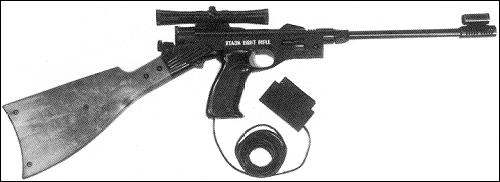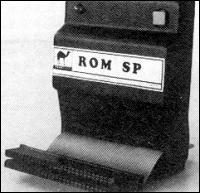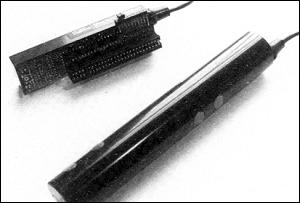| Hardware World |

IN THE DIM, dark past when video games consisted of black and white tennis with that distinctive 'boing', there was the then new idea of having a separate gun to fire at the TV screen. The Stack Light Rifle from Stack Computer Services takes the idea a stage further with a four-part sniper's rifle and high-resolution colour. The rifle is supplied with three games on tape, High Noon, Shooting Gallery and Grouse Shoot for the 48K Spectrum; it is also available for the Commodore 64 and the Vic-20.
The main pistol is attached to 12ft. of cable which ends in a dead-ended ZX-81-size connector which plugs into the Spectrum user port. To the pistol you can attach a barrel, stock and telescopic sight.
Of the three games, High Noon requires the greatest skill. In it a cartoon-style gun fighter will walk across the screen and you have six shots with which to kill him. Of the other games, Grouse Shoot entails shooting at rising birds while in Shooting Gallery you have to shoot a bouncing ball.
The rifle is well-made and surprisingly accurate. It is perhaps regrettable that the present trend towards death and destruction games should result in the appearance of such a device. If, however, that is what you want, then it is, arguably, the best of its type.
The Stack Light Rifle costs £29.95 inc. VAT from the manufacturer, Stack Computer Services, Merseyside or local retailers.

THE NEW ROM SP from Camel Products is a utility device which allows Spectrum users to retrieve programs stored in EPROMs. Up to 16K of EPROM can be used and there is the option of either having the program load on power up or by pressing a pushbutton.
The ROM SP can be used on both Spectrums but the Camel companion EPROM programmer, the PROMER-SP, would be difficult to use on the 16K machine because of lack of memory.
The unit is housed in a custom-designed ABS case and has a flexible connector to the Spectrum user port; on the rear is an extender card for other add-ons. On the top of the case there is a LED, which lights when a program is being transferred, and a push switch.
The unit worked well, the only difficulty being when used on an Issue 1 Spectrum.
For the dedicated EPROM user the unit is essential. Details of the Camel PROMER-SP were not available at the time of writing but a program is apparently provided to allow only essential data to be stored - Basic and/or machine code - to optimise space on the EPROM.
The ROM SP costs £29.95, as does the PROMER-SP, both plus VAT. EPROM erasers are also available from £18.95 plus VAT, all inclusive of p&p. Camel Products is at Cambridge.
MICROBYTE has launched a new software protection unit for the Spectrum. It is designed to prevent the computer crashing in the event of either mains noise or a power failure.
The Spectrum power supply is plugged into the unit and a lead is then plugged into the power socket of the Spectrum.
Inside the unit are six AA-type rechargeable batteries and, if there is a power failure, the batteries are kept topped-up and should last for up to 15 minutes. That will give you time to save a program if you have a battery-powered cassette player to hand.
The unit also contains a small circuit to cut mains interference. It is very disconcerting to load a program into the machine, switch it off at the mains and then switch it on again to find that you have not lost the program.
The unit is very easy to use. Once it is plugged in it can be forgotten and yet it gives great peace of mind. Costing £13.95 inc. for either the ZX-81 or Spectrum version, it may well save a good deal of frustration. Microbyte is at Lichfield, Staffordshire.
WITH ALL Sinclair products any deficiency is soon noted by peripheral makers. Abtron has produced a joystick adaptor lead for people with an Interface 2 which permits a joystick to simulate the cursor keys 5, 6, 7 and 8 and use 0 as fire.
The lead consists of two plugs which plug into the interface and a socket for the joystick. Priced at £7.99 inc. p&p, the lead can be obtained from Abtron, Walton-on-Thames.

THE LONG-AWAITED Trickstick from East London Robotics has been released. It is a 7in. long black plastic cylinder with six touch-sensitive pads which simulate the four usual joystick movements plus two fire buttons. It is complete with an interface which plugs into the back of the Spectrum. Up to eight can be plugged in at any time and there is an option to give proportional movement on specially-written games. Normally it simulates the Kempston joystick, so there are many games readily available on which it can be used.
The touch pads are drawing pins which use your body as an aerial to pick up mains hum. That is converted by the electronics to simulate the keypress. As some people are better 'aerials' than others, the sensitivity of the stick can be altered by a small screw near the top.
The stick was tried on a number of games, including the trainer tape supplied, and worked well. It takes some time to get used to it, unlike a joystick but, once mastered, was just as useful. The only difficulty is that you need two hands to use it, so for games where you have to use the keyboard as well as a joystick, you have to keep removing one hand.
If you are looking for a joystick, the Trickstick is worth considering. As it has no moving parts it should withstand a good deal of use and, provided you can spend time getting used to it, it is quicker than most joysticks.
Trickstick is available by mail order for £34.50 from East London Robotics Ltd, London.
THE LAUNCH of the Spectrum heralded an avalanche of graphics pads and software utilities. The Format 4 kit from Orion Software is undoubtedly the most comprehensive and certainly one of the best.
Housed in a smart black ring binder, the kit consists of two main parts. On the rings are 80 sheets of various-sized grids.
As well as that there is a clear plastic wallet to hold loose pieces of paper, a plastic ruler marked with a pixel scale and a translucent screen for placing over pictures with a full 32x24 grid, each square sub-divided into an 8x8 grid with markings round the sides showing the lines and columns, pixel positions and the memory addresses of each pixel line in hexadecimal.
Inside the front cover are a note pad, seven coloured pens to use on the various sheets, a water-soluble ink pen for use on the translucent screen, a calculator to help calculate the UDGs and a Cl5 cassette with an optional drawing program.
If you are looking for a serious graphics aid for a Spectrum this kit should be near the top of your list. The only part which is not necessary is the optional program.
The kit costs £16.95 or with the extra program £21.50, plus £2.50 p&p. The cassette is available separately at £6.50. A pack of refill sheets can be obtained for £3.95. If that is too costly, the SP2 kit consisting of translucent screen, pen and wallet is £3.75.Orion also produces Teleplan, a 32x22 grid on a piece of clear plastic which fixes on to a TV screen and is available for either 14in. or 16in. sets at £1.25 plus 50p p&p. More information from Orion Software Products, Surrey.
IN RECENT months there have been a number of disc systems appearing for the Spectrum, not to mention the Microdrive. One of the first was the Viscount system from Interactive Instruments.
The system comprises an interface which plugs into the back of a 48K Spectrum and a 51/4in. Shugart disc drive, complete with connecting cable. Interactive can supply an extension cable if necessary if you want to add a printer interface, for example. Also the interface will support only one drive and that has only single-sided discs but it manages to squeeze more than 107K on to them.
Setting up the system is very straightforward. On power-up the contents of the EPROM is loaded into the upper 8K of memory and a number of extra variables are added; they occupy another 110 bytes. Those variables are used to call the various functions of the interface.
The first step is to format a new disc, which is done by entering the command PRINT USR nd. Once formatted the disc will have 40 tracks, each 2,816 bytes long. The first track is always taken up with the directory, so you are left with 39 tracks, a total of 109,824 bytes of storage.
Both Basic and machine code can be made to autorun; code can also be made to load into a different area from the one from which it was saved. The way of filing f$ for arrays is a little complicated and arrays also have one major disadvantage.
Each time an array is saved you are limited to a length of 2,816 bytes, so if you were using a program which uses a string of 28,000 characters you would have to save it in pieces.
In use, the system is at least twice as fast as a Microdrive but the penalty is that it uses a good deal of RAM space.
That means that although it is ideal for business you cannot use programs such as Tasword or Masterfile on it. Transform Ltd, however, can supply some of its software on disc.
Overall, the system is ideal for home users who write their own programs or as part of a development system. The system can be obtained from the Spectrum chain of shops, costing £245 inc. or from the manufacturer, Interactive Instruments Ltd, Leicester.